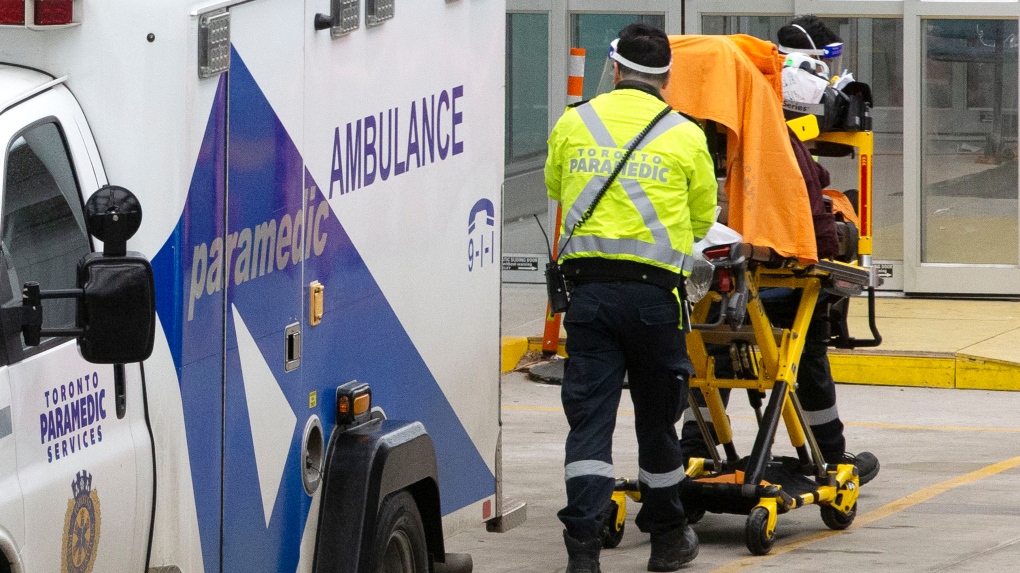Ontario's top doctor issues directive on patient transfers amid record hospitalizations
 Paramedics wheel a patient into the emergency department of a Toronto Hospital on Wednesday, January 5, 2022.THE CANADIAN PRESS/Chris Young
Paramedics wheel a patient into the emergency department of a Toronto Hospital on Wednesday, January 5, 2022.THE CANADIAN PRESS/Chris Young
Soaring COVID-19 hospitalizations have prompted Ontario's top doctor to issue a directive to support overwhelmed hospitals, integrating the transfer of patients across the province's health system.
Dr. Kieran Moore, Ontario's chief medical officer of health, issued Directive 2.1 Friday to provide hospitals guidance on moving patients from one facility to another.
According to the directive, hospitals should "transfer or support the transfer of patients, as appropriate, to other hospitals which have the capacity to provide treatment to patients, in order to maximize the capacity of the hospital system to provide and maintain care to the greatest number of patients as possible."
"Hospital Care Providers shall participate in any system coordination and reporting processes that may be established by Ontario Health for the purpose of optimizing of Ontario's hospital system to provide quality services to the greatest number of patients as possible," the directive read.
Ontario hospitals have been relying on patient transfer throughout the pandemic as a way to relieve the pressures brought on by COVID-19.
During the third wave, provincial officials issued emergency orders that gave hospitals the authority to transfer patients to another hospital without their consent. It was revoked in June 2021.
The Ministry of Health confirmed that under the directive, patient consent is required before a transfer.
The directive supplements the order issued earlier this month that suspended all non-emergent and non-urgent surgeries and procedures in hospitals and clinics in order to free up thousands of beds.
As of Friday, there are 3,814 people with COVID-19 in Ontario hospitals. Of those, 527 adults are in intensive care
Dr. Martin Betts, the chief of critical care at Scarborough Health Network, said the Omicron wave is evolving differently than the past pandemic waves. He noted that in Scarborough, they are seeing the highest number of COVID-19 patients ever.
"We're seeing about one in 10 hospitalized patients come to the ICU. During the delta wave, that was maybe one in three, and during prior waves, one in four, one in five," Betts said. "So, the pressure in the ICU is certainly great. But in our hospital wards, it's even greater. Hospitals are really going to unprecedented steps to accommodate patients both in terms of funding the space to do so. But also funding the staff as we've heard about so much."
Betts said they are planning to open a satellite facility in the coming days to accommodate the volume of patients.
Dr. Fahad Razak, an internist at St. Michael's Hospital and a member of the COVID-19 Science Advisory Table, said he has never seen health-care resources this depleted as doctors, nurses and other health professionals are getting infected with the virus.
"I did not see that occur at any other phase of the pandemic. So, this is really a very unusual time. And that makes it doubly difficult as you see these surges," Razak said.
Moore said Thursday that hospital admissions in the province could peak by next week. However, one Toronto doctor said the province is still far away from it.
"We are seeing more COVID patients every day," UHN infectious diseases specialist Dr. Abdu Sharkawy said Friday morning. "We're talking about opening more COVID units in our hospital and I hear the same thing from other hospitals in the GTA."
With files from CP24's Chris Herhalt
CTVNews.ca Top Stories

BREAKING Boissonnault out of cabinet to 'focus on clearing the allegations made against him,' Trudeau announces
Prime Minister Justin Trudeau has announced embattled minister Randy Boissonnault is out of cabinet.
Families of Paul Bernardo's victims not allowed to attend parole hearing in person, lawyer says
The families of the victims of Paul Bernardo have been barred from attending the serial killer’s upcoming parole hearing in person, according to the lawyer representing the loved ones of Kristen French and Leslie Mahaffy.
Baby dies after being reported missing in midtown Toronto: police
A four-month-old baby is dead after what Toronto police are calling a 'suspicious incident' at a Midtown apartment building on Wednesday afternoon.
How much do you need to earn to buy a home? Income requirements continue to ease
The average salary needed to buy a home keeps inching down in cities across Canada, according to the latest data.
'They squandered 10 years of opportunity': Canada Post strike exposes longtime problems, expert says
Canada Post is at ‘death's door’ and won't survive if it doesn't dramatically transform its business, a professor who has studied the Crown corporation is warning as the postal workers' national strike drags on.
'Bomb cyclone' batters B.C. coast with hurricane-force winds, downing trees onto roads and vehicles
Massive trees toppled onto roads, power lines and parked cars as hurricane-force winds battered the B.C. coast overnight during an intense “bomb cyclone” weather event.
Sask. woman who refused to provide breath sample did not break the law, court finds
A Saskatchewan woman who refused to provide a breath sample after being stopped by police in Regina did not break the law – as the officer's request was deemed not lawful given the circumstances.
Ford says there is 'clear consensus' among premiers for separate trade deal with Mexico
Ontario Premier Doug Ford says there is 'clear consensus' among premiers for separate bilateral trade deals with the U.S. and Mexico, following a phone call with all the leaders on Wednesday.
EV battery manufacturer Northvolt faces major roadblocks
Swedish electric vehicle battery manufacturer Northvolt is fighting for its survival as Canadian taxpayer money and pension fund investments hang in the balance.
































